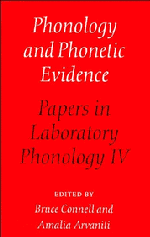Book contents
- Frontmatter
- Contents
- List of contributors
- Acknowledgments
- 1 Introduction
- I Features and Perception
- II Prosody
- III Articulatory Organization
- 15 Prosodic patterns in the coordination of vowel and consonant gestures
- 16 “Where” is timing? Comments on Smith
- 17 Asymmetrical prosodic effects on the laryngeal gesture in Korean
- 18 On a gestural account of lenis stop voicing in Korean: comments on Jun
- 19 A production and perceptual account of palatalization
- 20 An acoustic and electropalatographic study of lexical and postlexical palatalization in American English
- 21 What do we do when phonology is powerful enough to imitate phonetics? Comments on Zsiga
- 22 The influence of syntactic structure on [s] to [∫] assimilation
- 23 Assimilation as gestural overlap: comments on Hoist and Nolan
- 24 Orals, gutturals, and the jaw
- 25 The role of the jaw — active or passive? Comments on Lee
- 26 The phonetics and phonology of glottalized consonants in Lendu
- 27 Lendu consonants and the role of overlapping gestures in sound change: comments on Demolin
- Subject index
- Index of names
- Index of languages
27 - Lendu consonants and the role of overlapping gestures in sound change: comments on Demolin
Published online by Cambridge University Press: 03 May 2011
- Frontmatter
- Contents
- List of contributors
- Acknowledgments
- 1 Introduction
- I Features and Perception
- II Prosody
- III Articulatory Organization
- 15 Prosodic patterns in the coordination of vowel and consonant gestures
- 16 “Where” is timing? Comments on Smith
- 17 Asymmetrical prosodic effects on the laryngeal gesture in Korean
- 18 On a gestural account of lenis stop voicing in Korean: comments on Jun
- 19 A production and perceptual account of palatalization
- 20 An acoustic and electropalatographic study of lexical and postlexical palatalization in American English
- 21 What do we do when phonology is powerful enough to imitate phonetics? Comments on Zsiga
- 22 The influence of syntactic structure on [s] to [∫] assimilation
- 23 Assimilation as gestural overlap: comments on Hoist and Nolan
- 24 Orals, gutturals, and the jaw
- 25 The role of the jaw — active or passive? Comments on Lee
- 26 The phonetics and phonology of glottalized consonants in Lendu
- 27 Lendu consonants and the role of overlapping gestures in sound change: comments on Demolin
- Subject index
- Index of names
- Index of languages
Summary
Demolin's analysis of Lendu consonants as including a series of voiced and a series of voiceless implosives is quite convincing. I would like to raise only two small points: one about the details of the analysis of voiceless implosives, one about the plausibility of a sound change in which labial consonants develop into labial-velars.
Timing of events for voiceless implosives
A schematic gestural score for a (labial) voiceless implosive, similar to the one presented by Demolin, is shown in Figure 27.1a (for simplicity, tongue root expansion, which appears in Demolin's score, is omitted) The right edge of each box in such a score represents the end of active control of the particular constriction gesture, and thus is roughly the point of time at which the articulators begin to move away from the most constricted position, i.e., the “articulatory” release of the constriction (the acoustic release generally occurs somewhat later). The sequence of gestural releases implied by this score (and discussed) by Demolin is as follows: (1) release of glottal closure, (2) release of larynx lowering (i.e., onset of larynx raising), (3) release of labial closure.
There are two problems with this interpretation of the timing of release events. First, in Demolin's aerodynamic traces, the oral release seems to be occurring at a moment in time at which pharyngeal pressure is at a minimum. This would imply that the larynx was still lowering right up to oral release, and that larynx raising, then, does not begin until after oral release. This would imply a timing organization like that shown in Figure 27.1b.
- Type
- Chapter
- Information
- Phonology and Phonetic EvidencePapers in Laboratory Phonology IV, pp. 386 - 392Publisher: Cambridge University PressPrint publication year: 1995



